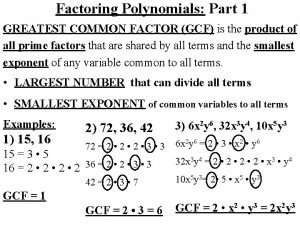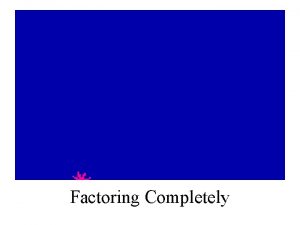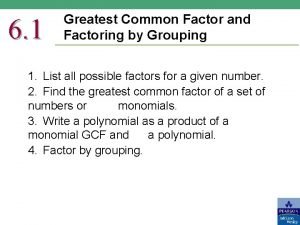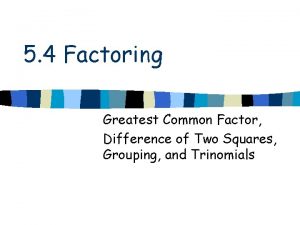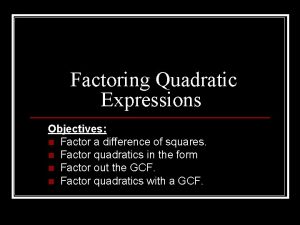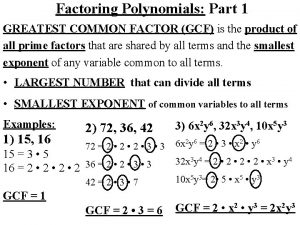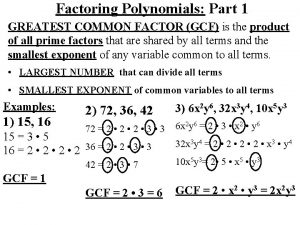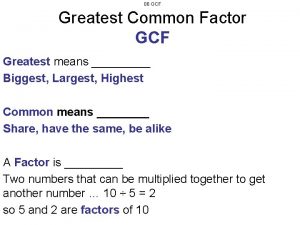Factoring Polynomials Part 1 GREATEST COMMON FACTOR GCF




![Factoring Polynomials: Part 2 Special Binomial (2 Term) Factoring Techniques [1] Difference of Squares Factoring Polynomials: Part 2 Special Binomial (2 Term) Factoring Techniques [1] Difference of Squares](https://slidetodoc.com/presentation_image_h/15a30c0240a01bf382a224662046abf3/image-5.jpg)

![[2] Sum and Difference of Cubes MEMORIZE! EXP#1: MEMORIZE! EXP#2: [2] Sum and Difference of Cubes MEMORIZE! EXP#1: MEMORIZE! EXP#2:](https://slidetodoc.com/presentation_image_h/15a30c0240a01bf382a224662046abf3/image-7.jpg)





- Slides: 12

Factoring Polynomials: Part 1 GREATEST COMMON FACTOR (GCF) is the product of all prime factors that are shared by all terms and the smallest exponent of any variable common to all terms. • LARGEST NUMBER that can divide all terms • SMALLEST EXPONENT of common variables to all terms Examples: 1) 15, 16 2) 72, 36, 42 3) 6 x 2 y 6, 32 x 3 y 4, 10 x 5 y 3 72 = 2 • 2 • 3 6 x 2 y 6 = 2 • 3 • x 2 • y 6 15 = 3 • 5 16 = 2 • 2 • 2 36 = 2 • 3 • 3 32 x 3 y 4 = 2 • 2 • x 3 • y 4 42 = 2 • 3 • 7 10 x 5 y 3= 2 • 5 • x 5 • y 3 GCF = 2 • 3 = 6 GCF = 2 • x 2 • y 3 = 2 x 2 y 3 GCF = 1

Find the GREATEST COMMON FACTOR (GCF) for each of the following group of terms (1) 45, 75 (2) 14, 49 (3) 36, 90, 42 (4) 36 x 2 y, 54 xy 2 z (5) 45 a 5 b 3, 60 a 2 b 7 (6) 4 pq 3, 15 qr 2 (7) 27 xy, 18 x, 12 x 2 (8) 144 a 2 b 2, 36 ab 2, (9) 25 r 3 s 6 t 2, 12 ab 15 r 5 s 2 t 3, 75 r 4 s 3 t

Factoring a polynomial by GREATEST COMMON FACTOR (GCF) “Reverse the Distributive Property” STEP #1: Find the GCF for all terms of polynomial STEP #2: Find Factored Polynomial by dividing all terms by GCF STEP #3: Factored Form = (Step #1)(Step #2) Exp 1: 10 x 3 z – 25 x 6 y Exp 2: 14 a 3 b 2 + 28 a 5 b 5 + 35 a 2 b 4 Step #1: GCF = 5 x 3 Step #1: Step #2: Step #3: 5 x 3(2 z – 5 x 3 y) Step #3:

FACTORING PRACTICE #1: Factor by the GCF (1) 72 a 3 – 50 ab 2 (2) 6 y 5 + 30 y 4 + 24 y 3 (3) 10 x 2 – 45 x + 35 (4) 2 xy – 10 x (5) 5 x 2 y 2 – 15 x 2 y (6) 12 x 2 – 42 xy + 9 y 2
![Factoring Polynomials Part 2 Special Binomial 2 Term Factoring Techniques 1 Difference of Squares Factoring Polynomials: Part 2 Special Binomial (2 Term) Factoring Techniques [1] Difference of Squares](https://slidetodoc.com/presentation_image_h/15a30c0240a01bf382a224662046abf3/image-5.jpg)
Factoring Polynomials: Part 2 Special Binomial (2 Term) Factoring Techniques [1] Difference of Squares MEMORIZE!! EXP#1: EXP#2: EXP#3:

FACTORING PRACTICE #2: Difference of Squares a) b) c) d) e) f)
![2 Sum and Difference of Cubes MEMORIZE EXP1 MEMORIZE EXP2 [2] Sum and Difference of Cubes MEMORIZE! EXP#1: MEMORIZE! EXP#2:](https://slidetodoc.com/presentation_image_h/15a30c0240a01bf382a224662046abf3/image-7.jpg)
[2] Sum and Difference of Cubes MEMORIZE! EXP#1: MEMORIZE! EXP#2:

FACTORING PRACTICE #3: Sum and Difference of Cubes a) b) c) d) e) f)

FACTORING PRACTICE #4: Check for GCF, then 2 Term Cases a) b) c) d) e) f)

Factoring Polynomials: Part 3 4 – Term Polynomials STEP #1: Check for GCF of entire polynomial STEP #2: Factor by Grouping • Split polynomial: FIRST two terms and the LAST two terms. • FACTOR the GCF from both sides of split • Check for negative and positive sign agreement • Factored Form: (1 st GCF + 2 nd GCF) (factored polynomial) Algebraic Example: 10 x 2 + 5 x + 6 x + 3 GCF = 5 x GCF = 3 5 x(2 x + 1) + 3(2 x + 1) a is first GCF and d is second GCF (5 x+ 3) (2 x + 1)

FACTORING PRACTICE #5: Factoring by Grouping a) c) b) d)

e) g) f) h)
 Lcm of 48 and 60
Lcm of 48 and 60 Factoring problems
Factoring problems Lesson 1 factoring using the greatest common factor
Lesson 1 factoring using the greatest common factor Factoring by gcf
Factoring by gcf Examples of greatest common factor
Examples of greatest common factor What is factored form
What is factored form Factor out the greatest common factor
Factor out the greatest common factor Lesson 1 factoring using the greatest common factor
Lesson 1 factoring using the greatest common factor Gcf of 72 and 90
Gcf of 72 and 90 Foil factoring
Foil factoring Factoring polynomials with gcf
Factoring polynomials with gcf Factoring polynomials gcf and quadratic expressions
Factoring polynomials gcf and quadratic expressions Prime factorization of 56
Prime factorization of 56

